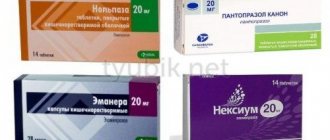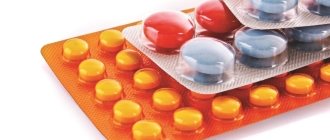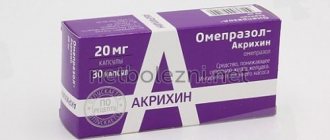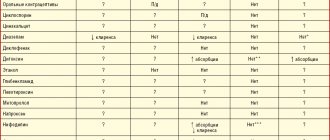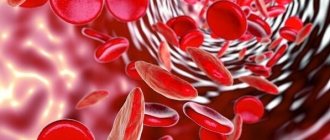| № | Name | Rating | Nomination |
| 1 | Khairabesol | 4.65 | Persistent relief of heartburn |
| 2 | Rabelok | 4.63 | The largest selection of dosage forms |
| 3 | Control | 4.55 | Best quality |
| 4 | Losek MAPS | 4.49 | Original drug omeprazole |
| 5 | Razo | 4.48 | Ease of reception |
| 6 | Nexium | 4.42 | An original drug at the same price |
| 7 | Emanera | 4.40 | Best price |
| 8 | Nolpaza | 4.32 | Optimal efficiency/price ratio |
| 9 | Pariet | 4.25 | Fastest action |
| 10 | Sanpraz | 4.04 | Does not interact with other medications |
Omeprazole is one of the most common drugs for the treatment of stomach diseases. It belongs to the proton pump inhibitors (PPIs), which inhibit the secretion of hydrochloric acid. In other words, the substance reduces the acidity of gastric juice, thereby eliminating heartburn and alleviating gastritis and ulcers. This is one of the cheapest inhibitors, which, despite its low price, has many advantages. Omeprazole is suitable for long-term use, rarely produces side effects and in most cases helps to cope with the unpleasant symptoms of gastritis. But for peptic ulcers and other serious diseases, it may not be highly effective. In these cases, doctors consider new generation Omeprazole analogues. Most of them are more expensive, but provide better treatment results. PPIs are divided into two generations. The first generation is omeprazole and lansoprazole, the second generation is pantoprazole and rabeprazole. PPI stereoisomers are isolated separately. They belong to the latest generation of drugs. These are esomeprazole and dexlansoprazole.
Comparison of Omeprazole analogues by main indicators
| Name | average cost | Active substance | Manufacturer country |
| Omeprazole | 31 rub. | omeprazole | Russia |
| The best analogues of Omeprazole of the new generation | |||
| Losek MAPS | 412 rub. | omeprazole | Sweden |
| Pariet | 2278 rub. | rabeprazole | Japan |
| Emanera | 209 rub. | esomeprazole | Slovenia |
| Control | 626 rub. | pantoprazole | Germany |
| Nolpaza | 372 rub. | pantoprazole | Russia |
| Khairabesol | 557 rub. | rabeprazole | India |
| Nexium | 447 rub. | esomeprazole | Sweden |
| Rabelok | 380 rub. | rabeprazole | India |
| Razo | 469 rub. | rabeprazole | India |
| Sanpraz | 485 rub. | pantoprazole | India |
There are contraindications! Consult your doctor!
Top 10. Sanpraz
Rating (2021): 4.04
Does not interact with other drugs The active substance pantoprazole has a low degree of interaction with other drugs. Therefore, it is prescribed to patients who have to take a lot of pills.
- Characteristics
Average price: 485 rub.
- Country: India
- Manufacturer: Sun Pharmaceutical Industries Ltd
- Active ingredient: pantoprazole
There are not many proton pump inhibitors based on pantoprazole. "Sanpraz" is one of the most common analogues, quite often prescribed by gastroenterologists. It is preferred if the patient is simultaneously taking medications for other diseases, since pantoprazole has low drug interactions. This especially applies to blood thinning drugs. In this case, relief comes quickly even when taken once a day. Side effects are not common, but dry mouth and constipation may occur. The price for the course is slightly higher than average, but in terms of effectiveness, Sanpraz is still somewhat inferior to some other drugs based on pantoprazole. For this, gastroenterologists slightly reduce the rating of the drug, considering it worthy, but not the best among analogues.
Advantages and disadvantages
- Often prescribed by gastroenterologists
- Low interaction with other drugs
- Convenient tablet form
- The effect is already at the beginning of the course
- Possible side effects
- Not the most effective of pantoprazoles
Mechanism of action
Both omeprazole and pantoprazole are benzimidazole derivatives, which results in similar physicochemical properties and pharmacological actions. Both drugs are prodrugs: they form the active form in the secretory tubules of parietal cells. It is into the lumen of the latter that parts of the molecules of the enzyme responsible for the main stage of the production of hydrochloric acid—H+/K+-ATPase—protrude.
Activation of omeprazole and pantoprazole occurs with the sequential addition of a hydrogen atom to the pyridine and benzimidazole rings. The main condition for activation is a strongly acidic environment, corresponding to that in the secretory tubules of parietal cells.
After ionization, omeprazole and pantoprazole can no longer penetrate the cell membrane and accumulate inside the tubules. The concentration of drugs in the lumen of the secretory tubules is 1000 times higher than the concentration in the blood and in the parietal cell. It is noteworthy that pantoprazole concentrates in the tubular lumen more slowly than omeprazole: the time required for 50% blockade of H+/K+ ATPase by omeprazole and pantoprazole is 400 and 1100 seconds, respectively. Thus, omeprazole is activated faster than pantoprazole and binds to the proton pump in a shorter time [2, 3].
The results of an in vitro study showed that omeprazole achieved maximum proton pump inhibition after 20 minutes of administration, and pantoprazole after 30 minutes.
Top 9. Pariet
Rating (2021): 4.25
The fastest action of Pariet relieves stomach pain due to peptic ulcers after taking the first tablet. This is the fastest acting proton pump inhibitor.
- Characteristics
Average price: 2278 rub.
- Country: Japan
- Manufacturer: Bushu Pharmaceuticals
- Active ingredient: rabeprazole
One of the most effective new generation PPIs. The drug should be considered as a substitute for Omeprazole if the prescribed treatment does not produce the desired therapeutic effect. The original drug rabeprazole brings relief from gastric ulcers already on the first day of use, so doctors prescribe it in the acute phase. During treatment, they note very rapid positive dynamics, which is not typical for other analogues in the pharmacological group. This is a modern drug without side effects, which can be called one of the best remedies for peptic ulcers and gastric erosion. The only serious drawback is the very high price, especially for use as a course. Many patients cannot afford it, which is why doctors rarely prescribe Pariet, preferring cheaper analogues.
Advantages and disadvantages
- Improves condition on the first day of use
- Fast positive dynamics
- High-quality original drug
- Rave reviews from doctors
- Very high price
Omeprazole or pantoprazole: hot points of discussion
Proton pump inhibitors (PPIs) occupy a leading place among the drugs for the treatment of diseases associated with high gastric acid production. Currently, this pharmacological group includes omeprazole, lansoprazole, pantoprazole, esomeprazole and rabeprazole. Some aspects of the debate regarding the benefits of a particular PPI need to be illuminated and understood. Particularly heated debates surround omeprazole and pantoprazole, which are similar in their pharmacodynamic characteristics and clinical effectiveness. Let us consider the differences discussed in the light of available information on the clinical pharmacology of these drugs.
Mechanism of action of PPIs
The mechanism of action of PPIs is the blockade of H+/K+-ATPase, the enzyme responsible for the main step in the formation of hydrochloric acid (HCl). Irreversible (or long-term) blockade of the enzyme explains the long duration of the main pharmacodynamic effect of PPIs, significantly exceeding the time these drugs remain in the blood. PPIs are benzimidazole derivatives and are prodrugs, that is, ideally they form an active form only in the secretory tubules of parietal cells, into the lumen of which sections of H+/K+-ATPase molecules protrude.
PPIs are unstable in an acidic environment; the likelihood of their penetration from the gastric cavity into the secretory tubules of parietal cells is negligible, especially in comparison with the transport capabilities of the microvasculature of the gastric mucosa. For this reason, minimizing losses during the delivery of the inactive substance to the parietal cell leads to increased effectiveness of these drugs. Protection of PPIs from HCl is technically solved by the use of enteric dosage forms that ensure the release of the active substance in the alkaline environment of the lumen of the small intestine.
Activation of PPI molecules occurs with sequential protonation of the pyridine and benzimidazole rings, and the addition of a hydrogen atom to the latter is possible only in the strongly acidic environment of the secretory tubules of parietal cells. When considering differences in the intensity of the main pharmacodynamic effect of various PPIs, attention is paid to the pKa values of their pyridine and benzimidazole rings (pKa1 and pKa2, respectively) (Table 1). pKa is the dissociation constant, in this case determined by the pH values at which half of the drug molecules are protonated: H+ is added to the nitrogen atom of the pyridine (pKa1) and benzimidazole (pKa2) rings. Protonation processes occur at a low rate even at pH > pKa, but when it decreases to the pKa level, half of the molecules are protonated, and at pH < pKa, the addition of hydrogen ions is significantly accelerated. pKa1 ranges from 3.83 (lansoprazole and pantoprazole) to 4.53 (rabeprazole). Omeprazole and esomepazole have pKa1 = 4.06. Thus, being in the intestinal contents with pH = 5.5, in the blood and cytosol of the parietal cell with pH = 7.4, PPI molecules are in non-ionized form, therefore they freely penetrate through biological membranes, including through the membranes of the secretory tubules of parietal cells . Once in the lumen of the tubules, PPIs are exposed to a strongly acidic environment with a pH of 1.2–1.3 and are ionized (protonated), losing the ability to pass back through the membrane, that is, a kind of “trap” is created for PPIs with an increase in their concentration in the lumen tubules 1000 times compared to the concentration in the blood and cytosol of the parietal cell [1–4]. Based on the indicated values, it is clear that among PPIs, drugs with higher pKa1 values accumulate faster in the secretory tubules of parietal cells. If we compare omeprazole and pantoprazole, we can see that pantoprazole concentrates noticeably more slowly in the tubular lumen than omeprazole.
The accumulation of an ionized drug as a substrate in the lumen of the secretory tubule helps to accelerate the second stage of its activation. After a series of intramolecular changes, the nitrogen atom of the benzimidazole ring is protonated. pKa2 is significantly lower than pKa1, ranging from 0.11 (pantoprazole) to 0.79 (omeprazole and esomeprazole). Lansoprazole and rabeprazole have pKa2 = 0.62. The higher the pKa2 value, the faster the nitrogen atom of the benzimidazole ring accepts a proton. Thus, omeprazole and esomeprazole are converted to their active form faster than pantoprazole, thereby being able to bind to proton pumps more quickly.
As a result of two-step activation (some intermediate intramolecular rearrangements are not mentioned), tetracyclic sulfenamide and sulfenic acid derivatives are formed, capable of forming disulfide bonds with mercapto groups of cysteine residues CYS813 and CYS822 of the proton pump with blockade of conformational transitions of the enzyme and the release of water molecules [1–4].
The resumption of acid production occurs due to the synthesis of new molecules of the enzyme H+/K+-ATPase, the entry of “reserve” molecules contained in tubulovisicles and inaccessible to drugs, and the rupture of disulfide bonds under the influence of endogenous glutathione.
For pantoprazole, slower proton binding is said to be beneficial. With rapid activation, omeprazole binds CYS813, while with delayed activation, pantoprazole also binds CYS822 to form sulfenic acid. Omeprazole blocks CYS822 only to a small extent. The association of PPI with CYS822 is resistant to the action of endogenous glutathione [4]. However, we can consider any difference in the chemical properties of a compound as an advantage of the drug only if it leads to an increase in the intensity of its main pharmacodynamic effect and an increase in the effectiveness of treatment with its use. And does a stronger connection of pantoprazole with H+/K+-ATPase matter if it is known that for any modern PPI it is practically irreversible, and the restoration of acid production depends not on its dissociation, but on the rate of incorporation of new proton pumps into the membrane of the secretory tubules of the parietal cells.
Pharmacokinetics
Differences in PPI pharmacokinetics are also discussed today. For example, one of the most discussed differences between omeprazole and pantoprazole is the higher bioavailability of pantoprazole (77%) that does not change with course use compared to omeprazole (35% with a single dose and 60% with course use). It would be logical to assume that, to achieve a similar antisecretory effect, a PPI with greater bioavailability should be used in lower doses. But at the same time, most studies have proven comparable clinical effectiveness of 40 mg of pantoprazole with half the dose of omeprazole - 20 mg.
In addition, the maximum concentration in the blood plasma when taking omeprazole occurs after approximately 0.5–3.5 hours, when taking pantoprazole - after 2.0–3.0 hours, and when taking, for example, rabeprazole, the time to reach the maximum concentration ranges from 2 to 5 hours [5–7]. At the same time, higher values of this parameter may contribute to a later arrival of the drug to the site of activation, and, conversely, a shorter time to reach the maximum concentration in the blood plasma of omeprazole theoretically indicates its faster entry into the parietal cell.
The half-life of the drugs in question varies slightly: 0.6–1.5 hours for omeprazole and 0.9–1.2 hours for pantoprazole. Due to the ability to concentrate in secretory tubules without re-penetrating into the vascular bed, the dependence of the pharmacodynamics of PPIs on pharmacokinetics is weak, and the duration of their main pharmacodynamic effect significantly exceeds the average retention time of the drug in the blood.
However, pharmacokinetic features cannot be an independent argument in favor of any PPI, nor can the color of its packaging. The advantages of one PPI over another, if any, can only be justified by the characteristics of pharmacokinetics, if the latter determine the optimization of its pharmacodynamics and clinical effectiveness. Does pantoprazole demonstrate pharmacodynamic and clinical advantages over omeprazole when prescribed at the same doses?
Pharmacodynamics of PPIs
When comparing the intensity of the main pharmacodynamic effect of PPIs, it is better to talk about the same doses of drugs. Publications often compare the antisecretory effect of 20 mg of one PPI with 40 mg of another, which artificially creates the idea that the drug used in a double dose is more pharmacodynamically effective. In this case, both pantoprazole and omeprazole can be used at a dose of 40 mg/day. In this regard, the results of a meta-analysis are interesting, which systematizes data on average daily gastric pH values during the use of various doses of PPIs in different categories of patients. And these data reliably demonstrate the lower antisecretory activity of pantoprazole compared to omeprazole: the calculated relative potential of the antisecretory effect, when compared with omeprazole (1.00), for pantoprazole is only 0.23 [2].
Thus, pantoprazole, prescribed in doses equal to omeprazole, is a less active proton pump inhibitor, and its higher and more stable (same for single and course use) bioavailability is not an argument in the discussion about the advantages of this drug.
Clinical effectiveness
It is known that the rate of repair processes in the mucous membranes of the esophagus and stomach is pH-dependent. For the healing of the gastric epithelium in peptic ulcer disease, the proportion of time during which the pH exceeds 3 is considered important. Therapy of NSAID gastropathy and gastroesophageal reflux disease (GERD) requires gastric pH values > 4 most of the day [8–13]. These pH levels can be achieved with any PPI; there are various national and international guidelines for their dosing and dose recalculation when replacing. For example, the WHO Collaborating Center for Drug Statistics Methodology and the Canadian Association of Gastroenterology consider doses of 20 mg/day omeprazole and 40 mg/day pantoprazole equivalent for the treatment of GERD (https:// www.whocc.no/atcddd/) [14].
Data from many clinical studies have been published that compared the effectiveness of different doses of omeprazole and pantoprazole in different categories of patients. Thus, in two blind, randomized studies, the identical clinical effectiveness of 20 mg/day omeprazole and 40 mg/day pantoprazole was proven, based on the results of endoscopic healing of duodenal ulcers for 2, 4 and 8 weeks of therapy [15, 16].
According to KD Bardhan et al. (1999), the use of omeprazole 20 mg/day and pantoprazole 40 mg/day does not demonstrate statistically significant differences in the level of healing in grade I esophagitis (according to the Savary-Miller classification). After 2 weeks of therapy with pantoprazole and omeprazole, GERD symptoms disappeared in 70% and 77%, respectively, and after 4 weeks - in 79% and 84%, respectively. After 4 weeks, in the groups of patients receiving pantoprazole and omeprazole, erosions were epithelialized in 84% and 89% of cases, respectively, and after 8 weeks - in 90% and 95% of cases, respectively [17].
According to a multicenter, double-blind comparative study conducted in France, omeprazole 20 mg/day and pantoprazole 40 mg/day are equally effective in the treatment of grade II and III reflux esophagitis (according to the Savary–Miller classification): according to endoscopic examination performed before and after 8 weeks of treatment, erosion healing occurred in 93% of patients receiving pantoprazole and 90% of patients receiving omeprazole [18].
The inclusion criteria for the meta-analysis were JJ Caro et al. (2001) there was epithelization of esophageal erosions or its absence when treated with omeprazole (20 mg/day) and pantoprazole (40 mg/day) for 8 weeks. No differences in the level of healing were found [19].
The equivalence of omeprazole 40 mg/day and pantoprazole in the treatment of grade II–III reflux esophagitis (Savary–Miller) was demonstrated in a randomized, double-blind, parallel group, multicenter study conducted in Austria, Germany, Portugal, Switzerland and the Netherlands. After 4 weeks, the proportion of patients with healed erosions when using omeprazole was 74.7%, and when using pantoprazole 77.4% [20].
Thus, published data from randomized studies prove the same clinical effectiveness of omeprazole prescribed at 20 mg/day and pantoprazole prescribed at 40 mg/day in the treatment of peptic ulcer, grade I reflux esophagitis and in 8-week therapy of II reflux esophagitis and III degree (according to Savary-Miller).
Metabolism, drug interactions
It is known that proton pump inhibitors undergo biotransformation mainly through CYP2C19 and CYP3A4. Rabeprazole is largely metabolized via non-enzymatic mechanisms. However, it is known that for some isoenzymes of the cytochrome P-450 system, as well as for a number of transport enzymes, H+/K+-ATPase blockers are inhibitors, which is of utmost importance for our understanding of drug interactions involving drugs of this pharmacological group (Table 2 ).
Thus, an in vitro study showed that pantoprazole, to a greater extent than omeprazole, inhibits CYP2C9 (Ki, respectively, 6.5 ± 1.0 and 16.4 ± 3.0 μM) and CYP3A4 (Ki, respectively, 21. 9 ± 2.7 and 41.9 ± 5.9 µM) [21]. The lower the value of the inhibition constant (Ki), the higher the inhibitory activity of the drug against the corresponding isoenzyme. CYP2C9 substrates include phenytoin, S-warfarin, tolbutamide, losartan, non-steroidal anti-inflammatory drugs (ibuprofen, diclofenac, piroxicam), irbesartan, carvedilol, etc. [22–24]. CYP3A4 is the predominant isoenzyme of cytochrome P450 with the largest number of substrates, which are amiodarone, amlodipine, atorvastatin, buspirone, verapamil, vincristine, hydrocortisone, dexamethasone, diazepam, disopyramide, itraconazole, carbamazepine, ketoconazole, clarithromycin, lovastatin, losartan, progesterone, propa phenon, rifampicin , salmeterol, simvastatin, fentanyl, fluconazole, quinidine, cyclosporine, cimetidine, erythromycin, etc. Glibenclamide, amitriptyline, imipramine are substrates of both CYP2C9 and CYP3A4 [22].
Data on drug interactions between proton pump inhibitors and substrate drugs of certain cytochrome P450 isoenzymes are contradictory: they contain opposite conclusions, references to fairly old publications and databases that have not been updated for a long time. The results of in vivo and in vitro studies differ. General information about drug interactions between drugs, including proton pump inhibitors, is contained, for example, in the online pharmaceutical encyclopedia www.drugs.com (USA).
The aspects of interaction between PPIs and clopidogrel are most often discussed today. Clopidogrel is a prodrug. Its active metabolites are formed mainly by CYP2C19, but also by CYP1A2, CYP2B6 and CYP2C9. Proton pump inhibitors are often prescribed together with clopidogrel to prevent mucosal damage and gastrointestinal bleeding. However, it has been shown that all PPIs are, to a greater or lesser extent, inhibitors of CYP2C19 and slow down the metabolic activation of clopidogrel, worsening its antiplatelet properties (Table 3) [25, 26].
The lower the Ki value of a PPI, the higher its inhibitory activity against CYP2C19. However, analysis of data from published studies suggests that the incidence of cardiovascular events with clopidogrel does not increase due to combined use with proton pump inhibitors [27–29].
Today, although debate regarding the interactions of PPIs with clopidogrel continues, guidelines from the European Medicines Agency (EMEA) and the Food and Drug Administration (FDA, USFDA) recommend avoiding PPIs if there are no indications, and if necessary, use pantoprazole, which is a weak inhibitor of CYP2C19 [30, 31].
Many cytochrome P450 isoenzymes are involved in the metabolism of benzodiazepines. For example, the biotransformation of diazepam is carried out by CYP3A4, CYP2C19, CYP3A5, CYP2B6, CYPCYP2C8, CYP2C9 [32]. Modern data are insufficient for a comparative assessment of the potential for interaction of omeprazole and pantoprazole with representatives of this pharmacological group.
The biotransformation pathways of the dextrorotatory and levorotatory isomers of warfarin are different. The S-enantiomer, which is 5 times more active than R-warfarin, is metabolized mainly by CYP2C9, while the R-enantiomer is metabolized by CYP2C9, CYP1A2, CYP2C19, CYP3A4 [22]. Proton pump inhibitors may alter the activity of CYP2C19 and CYP3A4, but the significance of this factor for the interaction of warfarin with omeprazole or pantoprazole still needs to be analyzed.
Thus, today, based on updated data on drug interactions, we can talk about the advantage of pantoprazole over omeprazole only when used together with clopidogrel or citalopram.
Adverse drug reactions
Based on published data on the safety of proton pump inhibitors, an analysis was carried out by type and prevalence of adverse drug reactions (ADRs). For omeprazole and pantoprazole, both the same ADRs (dizziness, headache, asthenia, skin rash, abdominal pain, constipation, diarrhea, flatulence, nausea, vomiting, cough, femoral neck fracture, rhabdomyolysis) and those occurring only in one of drugs (although the connection with the use of only one of the compared PPIs has not been proven). When using omeprazole, hepatotoxicity, pancreatitis, interstitial nephritis, fever (the frequency of NLRs is not specified), when using pantoprazole - Stevens-Johnson syndrome, Lyell's syndrome, thrombocytopenia (the frequency of NLRs is not specified); with a frequency of more than 1%, gastroenteritis, genitourinary tract infections, arthralgia, back pain, dyspnea, upper respiratory tract infections, and influenza-like syndrome occur [33].
Conclusion
Omeprazole is an effective and relatively safe drug for the treatment of diseases associated with high intensity gastric acid production.
Pantoprazole is a proton pump inhibitor, which, compared to omeprazole, has greater bioavailability, but less antisecretory activity and clinical efficacy in the treatment of peptic ulcers, reflux esophagitis of I degree and in 8-week therapy of reflux esophagitis of II and III degrees according to Savary-Miller (equivalent to daily doses of 20 mg omeprazole and 40 mg pantoprazole).
Of the two proton pump inhibitors, pantoprazole can definitely be recommended only if combined use with clopidogrel or citalopram is necessary.
Literature
- Kromer W., Kruger U., Huber R. et al. Differences in pH-dependent activation rates of substituted benzimidazoles and biological in vitro correlates // Pharmacology. 1998, Feb; 56 (2): 57–70.
- Kusano M., Kuribayashi S., Kawamura O., Shimoyama Y. et al. A Review of the Management of Gastric Acid-Related Diseases: Focus on Rabeprazole. Clinical Medicine Insights // Gastroenterology. 2011: 3, 31–343.
- Roche VF The Chemically Elegant Proton Pump Inhibitors // American Journal of Pharmaceutical Education. 2006; 70 (5), Article 101. R. 1–11.
- Shin JM, Sachs G. Pharmacology of Proton Pump Inhibitors // Curr Gastroenterol Rep. 2008, Dec; 10(6):528–534.
- Bell NJ, Burget D, Howden CW et al. Appropriate acid suppression for the management of gastrooesophageal reflux disease // Digestion. 1992; 51(Suppl 1): 59–67.
- Katashima M., Yamanoto K., Tokuma Y., Hata T. et al. Comparative pharmacokinetic/pharmacodynamic analysis of proton pump inhibitors omeprazole, lansoprazole and pantoprazole, in humans // Eur J Drug Metab Pharmacokin. 1998; 23: 19–26.
- Leonard M. Cleveland Clinic; 3 Huber R, Kohl B, Sachs G. et al. // Aliment Pharmacol Ther. 1995; 9: 363–378.
- Bell NJ, Hunt RH Role of gastric acid suppression in the treatment of gastro-oesophageal reflux disease // Gut. 1992; 33: 118–124.
- Burget DW, Chiverton SG, Hunt RH Is there an optimal degree of acid suppression for healing of duodenal ulcers? A model of the relationship between ulcer healing and acid suppression // Gastroenterology. 1990; 99: 345–351.
- Holloway RH, Dent J., Narielvala F., Mackinnon AM Relation between oesophageal acid exposure and healing of oesophagitis with omeprazole in patients with severe reflux oesophagitis // Gut. 1996; 38:649–654.
- Johansson KE, Ask P, Boeryd B, Fransson SG et al. Oesophagitis, signs of reflux, and gastric acid secretion in patients with symptoms of gastro-oesophageal reflux disease // Scand J Gastroenterol. 1986; 21:837–847.
- Laine L., Bombardier C., Hawkey C. J. et al. Stratifying the risk of NSAID-related upper gastrointestinal clinical events: results of a double-blind outcomes study in patients with rheumatoid arthritis // Gastroenterology. 2002, Oct; 123(4):z1006–1012.
- Kirchheiner J., Glatt S., Fuhr U., Klotz U., Meineke I. et al. Relative potency of proton-pump inhibitors - comparison of effects on intragastric pH // Eur J Clin Pharmacol. 2009, 65: 19–31.
- Armstrong D., Marshall JK, Chiba N., Enns R. et al. Canadian Consensus Conference on the management of gastroesophageal reflux disease in adults - update 2004 // Can J Gastroenterol. 2005; 19: 15–35.
- Rehner M., Rohner HG, Schepp W. Comparison of pantoprazole versus omeprazole in the treatment of acute duodenal ulceration—a multicentre study // Aliment Pharmacol Ther. 1995; 9 (4): 411–416.
- Witzel L., Gutz H., Huttemann W., Schepp W. Pantoprazole versus omeprazole in the treatment of acute gastric ulcers // Aliment Pharmacol Ther. 1995; 9 (1): 19–24.
- Bardhan KD, van Rensburg C., Gatz G. Comparison of pantoprazole (Panto) 20 mg versus omeprazole (Ome) 20 mg in patients with mild gastroesophageal reflux disease (GERD) (abstract) // Can J Gastroenterol. 1999; 13 (suppl B): 154 B.
- Vicari F., Belin J., Marek L. Pantoprazole 40 mg Versus Omeprazole 20 mg in the Treatment of Reflux Oesophagitis: Results of a French Multicentric Double-blind Comparative Trial // Acta Endoscopica. 1998; 28:451–456.
- Caro JJ, Salas M., Ward A. Healing and relapse rates in gastroesophageal reflux disease treated with the newer proton pump inhibitors lansoprazole, rabeprazole, and pantoprazole compared with omeprazole, ranitidine, and placebo: evidence from randomized clinical trials // Clin Ther. 2001; 23: 998-10-17.
- Korner T., Schutze K., van Leendert RJM, Fumagalli I. et. al. Comparable Efficacy of Pantoprazole and Omeprazole in Patients with Moderate to Severe Reflux Esophagitis Results of a Multinational Study // Digestion. 2003; 67:6–13.
- Li X., Andersson TB, Ahlstrom M., Weidolf L. Comparison of inhibitory effects of the proton pump-inhibiting drugs omeprazole, esomeprazole, lansoprazole, pantoprazole, and rabeprazole on human cytochrome p450 activities // Drug Metab Dispos. 2004; 32(8):821–827.
- Sychev D. A., Ramenskaya G. V., Ignatiev I. V., Kukes V. G. Clinical pharmacogenetics: Textbook / Ed. V. G. Kukesa, N. P. Bochkova. M.: GEOTAR-Media, 2007. 248 p.: ill.
- Bhasker CR, Miners JO, Coulter S et al. Allelic and functional variability of cyto-chrome P4502C9 // Pharmacogenetics. 1997; 7:51–58.
- Steward DJ, Haining RL, Henne KR et al. Genetic association between sensitivity to warfarin and expression of CYP2C9*3 // Pharmacogenetics. 1997; 7:361–367.
- Hulot JS, Bura A, Villard E et al. Cytochrome P450 2C19 loss-of-function polymorphism is a major determinant of clopidogrel responsiveness in healthy subjects // Blood. 2006; 108:2244–2447.
- Umemura K., Furuta T., Kondo K. The common gene variants of CYP2C19 affect pharmacokinetics and pharmacodynamics in an active metabolite of clopidogrel in healthy subjects // J Thromb Haemost. 2008; 6:1439–1441.
- O'Donoghue ML, Braunwald E, Antman EM et al. Pharmacodynamic effect and clinical efficacy of clopidogrel and prasugrel with or without a proton-pump inhibitor: An analysis of two randomized trials // Lancet. 2009, 9/19; 374(9694):989–997.
- Stanek EJ, Aubert RE, Flockhart DA, Kreutz RP et al. A national study of the effect of individual proton pump inhibitors on cardiovascular outcomes in patients treated with clopidogrel following coronary stenting: The clopidogrel Medco outcomes study // SCAI Scientific sessions. 2009. May, 6, 2009.
- Tan VP, Yan BP, Hunt RH, Wong BCY Proton pump inhibitor and clopidogrel interaction: The case for watchful waiting // Journal of Gastroenterology and Hepatology. 2010, 25, 1342–1347.
- European Medicines Agency. Public statement: interaction between clopidogrel and proton-pump inhibitors [Internet]. London: EMA; 2010. https://www.ema.europa.eu/docs/en_GB/document_library/Public_statement/2010/03/WC500076346.pdf.
- US Food and Drug Administration (FDA). Reminder to avoid concominant use of plavix (clopidogrel) and omeprazole [Internet]. Maryland: FDA; 2010. https://www.fda.gov/Drugs/DrugSafety/ucm231161.htm.
- Shou M., Mei Q., Michael W., Ettore M.W., Dai R. et al. Sigmoidal kinetic model for two co-operative substrate-binding sites in a cytochrome P450 3 A4 active site: an example of the metabolism of diazepam and its derivatives // Biochem J. 1999; 340:845–853.
- Therapeutic Class Review Proton Pump Inhibitors Single Entity Agents. Department of Vermont Health Access. 2010. 53 p.
S. Yu. Serebrova, Doctor of Medical Sciences, Professor
GBOU VPO First Moscow State Medical University named after. I. M. Sechenova Ministry of Health of the Russian Federation, Moscow
Contact information about the author for correspondence
Top 8. Nolpaza
Rating (2021): 4.32
Optimal ratio of effectiveness and price A relatively cheap analogue of pantoprazole is not inferior in effectiveness to expensive drugs. The pronounced effect is noticeable after 3-5 days of use.
- Characteristics
Average price: 372 rub.
- Country Russia
- Manufacturer: KRKA-RUS
- Active ingredient: pantoprazole
Doctors consider Nolpaza one of the best proton pump inhibitors. Compared to other drugs based on pantoprazole, the drug is inexpensive, but shows no less effectiveness. Available in the form of small tablets that are easy to swallow. The main active ingredient does not interact with other medications, so doctors give preference to the drug when selecting therapy for patients with concomitant diseases. Tolerability is good, without side effects. A slight improvement is observed after the first dose, with a pronounced result after 3-5 days. Another advantage is its availability - the drug is always available in pharmacies. Disadvantages - contraindicated for pregnant women, prescribed in relatively short courses, uncontrolled use is unacceptable.
Advantages and disadvantages
- Does not interact with other medications
- Does not give side effects
- Pronounced effect after 3-5 days
- Available in small tablets
- Contraindicated in pregnant women
- Use only as prescribed by a doctor
Conclusion
Omeprazole and pantoprazole have comparable antisecretory activity (at doses of 20 mg per day and 40 mg per day, respectively) and safety profile. The main differences between the drugs are their ability to inhibit isoenzymes of the cytochrome P450 system and the associated drug-drug interactions. For patients who need to take a PPI in combination with clopidogrill and citalopral, it is more advisable to opt for pantoprazole, as a drug with lower inhibitory activity against the isoenzyme involved in the activation of the corresponding antiplatelet or antidepressant.
Sources
- The Top 300 of 2022. Provided by the ClinCalc DrugStats Database. URL: https://clincalc.com/DrugStats/Top300Drugs.aspx (accessed 07/24/2021).
- Kusano M., Kuribayashi S., Kawamura O., Shimoyama Y. et al. A Review of the Management of Gastric Acid-Related Diseases: Focus on Rabeprazole. Clinical Medicine Insights // Gastroenterology. 2011: 3, 31–343.
- Roche VF The Chemically Elegant Proton Pump Inhibitors // American Journal of Pharmaceutical Education. 2006; 70(5), Article 101:1–11.
- Maev I.V., Oganesyan T.S., Kucheryavyi Yu.A. Comparative effectiveness of triple first-line anti-helicobacter therapy using pantoprazole and omeprazole // Attending physician, 2010. T. 2. P. 2-7.
- De Francesco V., Margiotta M., Zullo A. et al. Clarithromycin-resistant genotypes and eradication of Helicobacter pylori // Ann. Intern. Med. 2006; 144:94–100.
- Kudryavtseva L.V., Isakov V.A.. Ivannikov I.O. et al. Resistance of Helicobacter pylori to metronidazole, clarithromycin and amoxicillin in Moscow, St. Petersburg and Abakan in 2001 // Pediatrics, 2002. No. 2 ( Application). pp. 61–63.
- Sjostedt S., Sagar M., Lindberg G. et al. Prolonged and profound acid inhibition is crucial in Helicobacter pylori treatment with a proton pump inhibitor combined with amoxicillin // Scand. J. Gastroenterol. 1998; 33: 39–43.
- Sachs G. Synthesis or rupture: duration of acid inhibition by proton pump inhibitors // Drugs Today. 2003. Vol. 39 (Suppl. A). R. 11–14.
- Lapina O. D. Mechanism of action of proton pump inhibitors // Ros. magazine gastroenterol., hepatol., coloproctol., 2002. No. 2. P. 38–44.
- Pan WJ et al. Lack of a pharmacokinetic interaction between lansoprazole or pantoprazole and theophylline // Aliment. Pharmacol. Ther. 2000; 14 (3): 345–52.
- Blume H., Donath F., Warnke A., Schug BS Pharmacokinetic Drug Interaction Profiles of Proton Pump Inhibitors // Drug Safety. 2006; 29(9):769–784.
- Juurlink DN, Gomes T, Ko DT et al. A population-based study of the drug interaction between proton pump inhibitors and clopidogrel // CMAJ. 2009; 180: 713–718.
- Bliesath H. et al. Pantoprazole does not interact with nifedipine in man under steady-state conditions // Int. J. Clin. Pharmacol. Ther. 1996. Vol. 34 (1 Suppl.). S81–85.
Top 7. Emanera
Rating (2021): 4.40
Best price Among Omeprazole substitutes, this drug has the most affordable price. The new generation medicine costs a little more than 200 rubles.
- Characteristics
Average price: 209 rub.
- Country: Slovenia
- Manufacturer: KRKA
- Active ingredient: esomeprazole
The modern new generation Omeprazole substitute is also a proton pump inhibitor, but has higher bioavailability. Therefore, the effect of treatment is achieved much faster. "Emanera" already at the beginning of the course relieves the symptoms of stomach diseases. Taking courses reliably protects against relapses. Among all drugs based on esomerpazole, many doctors prefer the pharmacological version, which is an order of magnitude more effective than the cheap Omeprazole, but at the same time it also has a more than affordable price. This is the best option for those who are looking for a modern substitute for an outdated product without harming their wallet. The drug has virtually no side effects, but requires gradual withdrawal to avoid relapses.
Advantages and disadvantages
- Brings relief quickly
- Optimal price-performance ratio
- Does not give side effects
- New generation drug
- Requires gradual withdrawal
- Not sold in all pharmacies
Top 6. Nexium
Rating (2021): 4.42
An original drug at the price of analogues Nexium is the cheapest original drug among proton pump inhibitors. At the same time, it is high quality and effective.
- Characteristics
Average price: 447 rub.
- Country: Sweden
- Manufacturer: AstraZeneca AB
- Active ingredient: esomeprazole
The original drug esomeprazole of the famous brand Astra Zeneca. Just a few years ago it was very expensive and was inaccessible to many patients. Then the price dropped several times due to the pharmaceutical company's affordability policy. The drug has been well researched, safe and effective in the treatment of diseases of the stomach, esophagus and duodenum. The stereoisomer of PPI is characterized by greater bioavailability, so a pronounced therapeutic effect is achieved already in the first days of treatment. The drug is prescribed in long courses and is well tolerated by patients. Like all similar drugs, it can cause “rebound syndrome” upon withdrawal, which is manifested by severe heartburn and deterioration in well-being. To avoid this, doctors prescribe a gradual withdrawal regimen.
Advantages and disadvantages
- Original drug at an affordable price
- Good research base
- Positive feedback from patients and doctors
- Fast action and effectiveness
- If the o
What substitutes are there?
In the case of the best analogues of Omeprazole, the following drugs can be called:
- Nolpaza;
- Pantoprazole – III generation;
- Lansoprazole – II generation;
- Rabeprazole – IV;
- Dexlansoprazole, Esomeprazole – the latest V, VI generation of PPI stereoisomers;
- Kvamatel;
- Razo;
- Nexium;
- Emanera;
- Famotidine.
Second generation medicinal analogues include Lansoprazole medications:
- Lancid;
- Lanzabel;
- Epicurus.
Each new generation of PPIs is characterized by greater bioavailability.
III generation PPIs are the Pantoprazole group:
- Crosacid;
- Sanpraz;
- Panum;
- Control;
- Nolpaza.
New generation medications do not have an extensive list of side effects and are distinguished by their speed, strength of action, duration of action, and purity of components. IV generation includes the Rabeprazole group:
- Works;
- Pariet;
- Khairabesol;
- Rabelok;
- Zulbex;
- Razo.
In 2001, Japanese and US researchers received the Nobel Prize in Chemistry for the separation of S-R-stereoisomers. The technology formed the basis for the development of Esomeprazole with pronounced antisecretory activity and high bioavailability.
Esomeprazole is an isomer of the already known Omeprazole, it has a composition similar to the main substance, but its atomic composition is different. This is the main reason for the new properties and characteristics.
The isomer is most often prescribed for reflux esophagitis and gastric ulcers. Slow elimination from the body provides a longer-lasting effect with a pronounced anti-secretory effect. Stable suppression of secretion appears already on the 5th day of treatment.
Top 5. Razo
Rating (2021): 4.48
Ease of administration Razo comes in the form of small tablets that are easy to swallow. And you only need to take them once a day.
- Characteristics
Average price: 469 rub.
- Country: India
- Manufacturer: Dr. Reddy's
- Active ingredient: rabeprazole
A high-quality rabeprazole drug from a reliable Indian company. Quickly copes with increased acidity, eliminates heartburn, and with long-term course use, heals erosions and ulcers. More often used in complex therapy. Gastroenterologists prescribe Razo in long courses until a lasting therapeutic effect is achieved. Conveniently, the absorption of the active substance does not depend on food intake. You need to take the drug once a day, at any time of the day. The drug is available in the form of small tablets of 10 mg and 20 mg, the packaging is designed for a month of administration. Taking this into account, the price of the course is quite affordable. Among the side effects, patients in reviews occasionally mention nausea at the beginning of the course. The disadvantages include not being available in all pharmacies.
Advantages and disadvantages
- High efficiency at an affordable price
- Easy to swallow small tablets
- Take once a day
- Quickly relieves heartburn and stomach pain
- Not sold in all pharmacies
- Nausea at the beginning of the course
Pharmacokinetic and pharmacodynamic properties
Omeprazole and pantoprazole differ from each other in at least two pharmacokinetic parameters.
Bioavailability
Omeprazole is 35% with a single dose and 60% when taken as a course, while the bioavailability of pantoprazole at a course dose reaches 77%. It should be noted that, despite the significant difference in the bioavailability of the drugs, their clinical effectiveness in equal doses is not comparable. According to research results, the acid-blocking effect of 20 mg of omeprazole is comparable to the effectiveness of pantoprazole at a dose of 40 mg [4].
Time to reach maximum concentration
in blood plasma for omeprazole is 0.5–3.5 hours. Pantoprazole reaches maximum concentration 2–3 hours after administration. Obviously, the difference between the upper and lower limits for achieving this indicator does not allow us to correctly compare drugs and draw a definite conclusion.
Top 4. Losek MAPS
Rating (2021): 4.49
The original omeprazole drug Losec MAPS belongs to the first generation of PPIs, but in quality and effectiveness it is many times superior to the Russian Omeprazole. This is an original drug, often prescribed by doctors.
- Characteristics
Average price: 412 rub.
- Country: Sweden
- Manufacturer: AstraZeneca AB
- Active ingredient: omeprazole
The original “brand” drug omeprazole, despite the emergence of new generation tablets, still remains the gold standard of antisecretory therapy. This he owes to safety and proven effectiveness. Russian "Omeprazole" is a generic and is significantly inferior to the original drug in terms of therapeutic effect. This is noted by both doctors and patients. Losec MAPS is the best medicine based on omeprazole. Sustained improvement is observed after a short course of use. Long-term therapy reduces the relapse rate. The high quality of the drug minimizes the severity of side effects. And its safety allows it to be prescribed to pregnant women to relieve heartburn. Doctors say the only significant drawback is the high cost of the drug, due to which many patients abandon the original drug in favor of a cheap Russian generic.
Advantages and disadvantages
- Original high quality product
- Fast therapeutic effect
- No side effects
- Positive reviews from doctors
- High price
Top 3. Control
Rating (2021): 4.55
Best quality A high-quality drug made in Germany has earned the trust of gastroenterologists and patients. It quickly helps to cope with stomach diseases without side effects.
- Characteristics
Average price: 626 rub.
- Country: Germany
- Manufacturer: Takeda
- Active ingredient: pantoprazole
A high-quality drug for the treatment of gastritis, peptic ulcers and other stomach diseases. It belongs to a new generation of PPIs and is well tolerated without side effects, provided that the dosage is correctly prescribed and gradual withdrawal. It comes in tablet form, which many patients like because they are easier to swallow than capsules. The drug is produced in Germany, is not cheap, but is highly effective. This is a worthy substitute for Omeprazole - a more modern and effective drug. The peculiarity of pantoprazole is the minimum frequency of drug-drug interactions, which makes it possible to prescribe Controloc to patients taking many medications at the same time. Based on the use of the drug in practice, doctors leave only positive reviews. Patients are satisfied with the result, but the price seems high to them.
Advantages and disadvantages
- No side effects
- Does not interact with other medications
- Convenient tablet form
- High quality and efficiency
- Expensive drug
See also:
- 10 Best Proton Pump Inhibitors
general information
Omeprazole is the first PPI, synthesized back in 1978 and entering clinical practice 10 years later. 40 years later, it became one of the best-selling drugs in the world: in the United States alone, 58 million prescriptions for this drug were issued in 2022. The actual sales volumes of the drug are much higher, since one of its forms belongs to the OTC group, both in the Russian Federation and in many other countries of the world [1].
Pantoprazole appeared a little later than its predecessor: its research began in 1985, and in 1994 the drug was already registered in Germany. In 2022, there were approximately 29 million prescriptions written for pantoprazole in the United States [1].
Top 2. Rabelok
Rating (2021): 4.63
The largest selection of dosage forms The medicine is available in tablets of various dosages and in the form of an injection solution. This gives the doctor more opportunities to select an individual treatment regimen and quickly help patients.
- Characteristics
Average price: 380 rub.
- Country: India
- Manufacturer: Cadila Healthcare
- Active ingredient: rabeprazole
An effective drug of a new generation, one of the most successful substitutes for Omeprazole. It is widely used in gastroenterology, prescribed for gastritis, ulcers, esophagitis and other diseases of the stomach. Available in tablets of 10 mg and 20 mg, which allows you to more accurately select your individual dosage. There is an injection solution available for quick relief in severe cases. It acts quickly and gives a stable therapeutic effect if the treatment regimen is followed. There are no undesirable side effects; upon withdrawal it does not cause pronounced “rebound syndrome”. Can be prescribed in long courses. According to reviews from doctors and patients, erosions heal completely within 8 weeks of use, and the effect of treatment lasts for a long time. A small minus is that the drug is not sold in all pharmacies.
Advantages and disadvantages
- Different release forms and dosages
- High efficiency
- No side effects or rebound syndrome
- Long-term effect after a course of administration
- Low availability in pharmacies
See also:
- 20 best medicines for gastritis
Cost of Omeprazole and its analogues
Prices for Omeprazole, as well as the main medications that can replace it, are shown in the table.
| Drug name | Release form | Qty./pack. | AB dose (mg/piece) | Price in rubles | Pharmacy name |
| Omeprazole | Capsules | №30 | 20 | 41 | ZdravCity |
| Ultop | Capsules | №28 | 10 | 179 | ZdravCity |
| Losek MAPS | Pills | №28 | 20 | 626 | E Pharmacy |
| Control | Pills | №28 | 40 | 610 | LanaFarm |
| Rabelok | Pills | №14 | 20 | 487 | E Pharmacy |
| Nolpaza | Pills | №56 | 20 | 394 | Piluli.ru |
| Pantoprazole Canon | Pills | №28 | 40 | 283 | ZdravCity |
| Nexium | Pills | №28 | 40 | 230 | Omnifarm |
| Neo-Zext | Pills | №14 | 40 | 226 | Omnifarm |
| Zulbex | Pills | №14 | 20 | 850 | Wer.ru |
| Noflux | Pills | №14 | 10 | 453 | Neopharmacy |
The choice of an analogue should be made taking into account the disease, its severity and possible contraindications.
